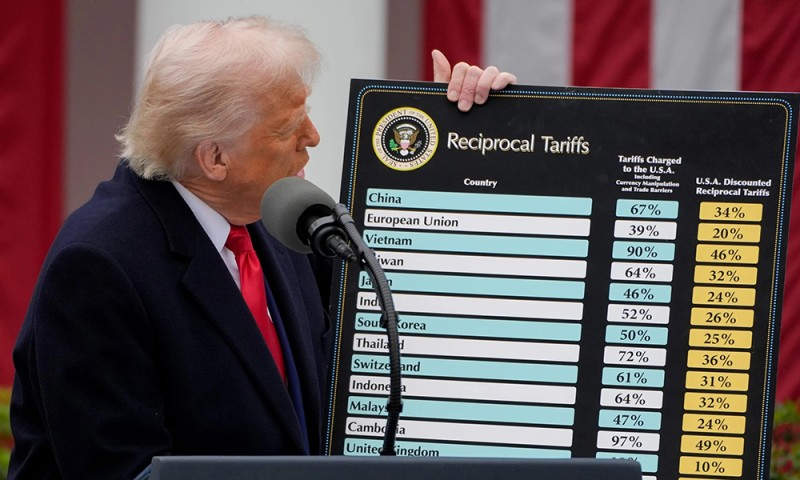
• 唐纳德·特朗普的关税政策正以每年约3,000亿美元的速度为联邦政府创收。尽管这看似是一个前景可观的资金来源,但关税政策凭总统签字即可生效,同样也能一纸废除。穆迪分析(Moody’s Analytics)首席经济学家马克·赞迪指出,当再次发生经济衰退时,必将出现要求减免关税以纾解民困的呼声。
穆迪分析首席经济学家马克·赞迪表示,虽然联邦政府有望从唐纳德·特朗普的关税措施中获得可观的财政收入,但这并不是一项可靠的资金来源,尤其是在经济衰退时期。
耶鲁大学预算实验室(Yale’s Budget Lab)的数据显示,当前平均实际关税税率已达20.2%,创1911年以来的新高。基于现有关税收入测算,关税年创收规模应约达3,000亿美元。
尽管这远不足以填补预计今年将扩至近2万亿美元的联邦预算赤字,但仍然是一个重要的收入来源。然而,为什么不能将关税收入作为长期收入来源?
在上周三专注削减国债的无党派组织“协和联盟”(Concord Coalition)旗下的最新一期《面向未来》(Facing the Future)播客节目中,赞迪强调关税政策经行政令实施,而且可能被随时撤销。
此外,所谓“对等关税”正面临司法质疑,质疑者主张其不在《国际紧急经济权力法》(International Emergency Economic Powers Act)的适用范围内。
因此,赞迪警告称,切勿据此推定关税政策将长期存续而制定其他税收和支出决策。一旦经济下行,所有预期都将落空。
他补充道:“我预判当经济再次陷入衰退时——虽然不会马上发生,但未来终将发生——无论谁主政白宫,都将承受削减关税的巨大压力,因为他们只需要一纸行政令就能削减关税,无需国会立法。”
经济衰退或许会提前发生。本月初,赞迪警告称经济已濒临衰退边缘。
上周日,他进一步指出,尽管美国尚未陷入经济衰退,但政府数据追踪的近400个行业中,超半数已开始裁员,这种现象历来都伴随着经济下行。
与此同时,关税的大多数成本被转嫁给消费者,这意味着这些进口税实际上就是销售税。高盛(Goldman Sachs)计算得出,约67%的关税成本正由消费者承担。
赞迪对协和联盟的卡罗琳·布尔多与罗伯特·比克斯比表示:“总统将有强烈的动机宣告:‘我将实施减税。’”
尽管特朗普曾提议利用关税收入向民众发放某种形式的股息或退税,但白宫坚称关税成本并非由消费者承担,而是由外国出口商消化。
赞迪认为无论何种情况,未来十年关税年创收3,000亿美元的可能性极低,并警示勿寄望于这种巨额横财。
他补充道:“事实上,如果政府依赖这个资金来源,美国的财务状况将更加严峻和糟糕,因为我确信这些关税不可能存在十年之久。”(*)
译者:刘进龙
审校:汪皓
• 唐纳德·特朗普的关税政策正以每年约3,000亿美元的速度为联邦政府创收。尽管这看似是一个前景可观的资金来源,但关税政策凭总统签字即可生效,同样也能一纸废除。穆迪分析(Moody’s Analytics)首席经济学家马克·赞迪指出,当再次发生经济衰退时,必将出现要求减免关税以纾解民困的呼声。
穆迪分析首席经济学家马克·赞迪表示,虽然联邦政府有望从唐纳德·特朗普的关税措施中获得可观的财政收入,但这并不是一项可靠的资金来源,尤其是在经济衰退时期。
耶鲁大学预算实验室(Yale’s Budget Lab)的数据显示,当前平均实际关税税率已达20.2%,创1911年以来的新高。基于现有关税收入测算,关税年创收规模应约达3,000亿美元。
尽管这远不足以填补预计今年将扩至近2万亿美元的联邦预算赤字,但仍然是一个重要的收入来源。然而,为什么不能将关税收入作为长期收入来源?
在上周三专注削减国债的无党派组织“协和联盟”(Concord Coalition)旗下的最新一期《面向未来》(Facing the Future)播客节目中,赞迪强调关税政策经行政令实施,而且可能被随时撤销。
此外,所谓“对等关税”正面临司法质疑,质疑者主张其不在《国际紧急经济权力法》(International Emergency Economic Powers Act)的适用范围内。
因此,赞迪警告称,切勿据此推定关税政策将长期存续而制定其他税收和支出决策。一旦经济下行,所有预期都将落空。
他补充道:“我预判当经济再次陷入衰退时——虽然不会马上发生,但未来终将发生——无论谁主政白宫,都将承受削减关税的巨大压力,因为他们只需要一纸行政令就能削减关税,无需国会立法。”
经济衰退或许会提前发生。本月初,赞迪警告称经济已濒临衰退边缘。
上周日,他进一步指出,尽管美国尚未陷入经济衰退,但政府数据追踪的近400个行业中,超半数已开始裁员,这种现象历来都伴随着经济下行。
与此同时,关税的大多数成本被转嫁给消费者,这意味着这些进口税实际上就是销售税。高盛(Goldman Sachs)计算得出,约67%的关税成本正由消费者承担。
赞迪对协和联盟的卡罗琳·布尔多与罗伯特·比克斯比表示:“总统将有强烈的动机宣告:‘我将实施减税。’”
尽管特朗普曾提议利用关税收入向民众发放某种形式的股息或退税,但白宫坚称关税成本并非由消费者承担,而是由外国出口商消化。
赞迪认为无论何种情况,未来十年关税年创收3,000亿美元的可能性极低,并警示勿寄望于这种巨额横财。
他补充道:“事实上,如果政府依赖这个资金来源,美国的财务状况将更加严峻和糟糕,因为我确信这些关税不可能存在十年之久。”(*)
译者:刘进龙
审校:汪皓
• President Donald Trump’s tariffs are generating revenue for the federal government at an annual rate of about $300 billion. While that sounds like a promising source of funding, tariffs went into effect with the stroke of a pen, and they can go away with one, too. And in the next recession, there will be calls for tariff relief to help consumers, Moody’s Analytics chief economist Mark Zandi said.
The federal government is on pace to reap a significant amount of revenue from President Donald Trump’s tariffs, but they may not be a reliable source of funding, especially in a recession, according to Moody’s Analytics chief economist Mark Zandi.
The average effective tariff rate is now 20.2%, the highest since 1911, according to Yale’s Budget Lab. Based on the revenue tariffs are generating so far, they should bring in about $300 billion annually.
Though that’s not nearly enough to eliminate the federal budget deficit, which is expected to widen to almost $2 trillion this year, it’s still a meaningful amount. So why not rely on them as a long-term revenue source?
On last Wednesday’s episode of the Facing the Future podcast from the Concord Coalition, a nonpartisan group focused on reducing the national debt, Moody’s Analytics chief economist Mark Zandi pointed out tariffs were imposed via executive order and can be changed in an instant.
In addition, the so-called reciprocal tariffs are facing court challenges on the argument they’re not covered under the International Emergency Economic Powers Act.
As a result, Zandi cautioned against making other tax and spending decisions based on the assumption those tariffs will remain in place. And if the economy goes south, then all bets are off.
“I suspect that the next time the economy gets into recession—and it will, maybe not this go around, but at some point it will—whoever’s president is going to be under significant pressure to cut those tariffs because they can do it under executive order. They don’t need to go to Congress to get a piece of legislation,” he added.
A downturn may even come sooner rather than later. Earlier this month, Zandi warned the economy is on the brink of a recession.
On Sunday, he followed that up, saying while the U.S. isn’t in a recession now, more than half of the roughly 400 industries tracked in government data are already shedding workers, a phenomenon that’s accompanied previous downturns.
Meanwhile, most of the cost of tariffs is being passed on to consumers, meaning those import taxes are effectively sales taxes. Goldman Sachs calculated that around 67% of the tariff costs are being passed on to consumers.
“There’s going to be a strong incentive on that president’s part to say, ‘Okay, I’m going to cut the taxes,’” Zandi told the Concord Coalition’s Carolyn Bourdeaux and Robert Bixby.
While Trump has floated the idea of using tariff revenue to provide some kind of dividend or rebate to Americans, the White House insists consumers are not shouldering tariff costs and that foreign exporters are.
Either way, Zandi said he thinks it’s highly unlikely that tariffs will generate $300 billion a year over the next decade and warned against counting on a windfall like that.
“In fact, if you did do that, we’re setting ourselves up for an even more dire, darker fiscal situation down the road, because I just don’t think those tariffs are going to be around 10 years from now,” he added.

